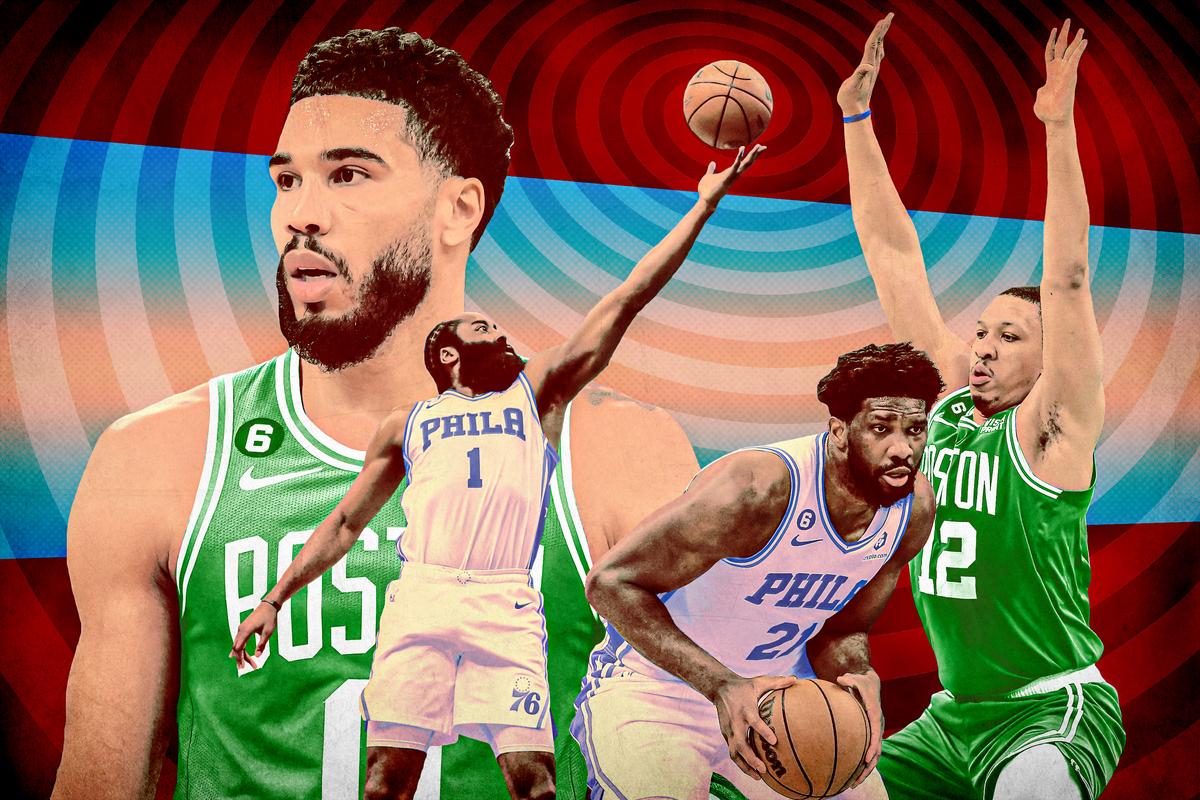
As everyone expected: The 76ers won when Joel Embiid was out, then lost when he returned to the lineup.
OK, so the order of events might not have conformed to plan, but the ultimate outcome is the same: The Celtics-76ers second-round clash is tied 1-1 as it heads to Philadelphia for the weekend.
Philadelphia surprisingly stole Game 1, 119-115, thanks to 45 points and a game-winning 3 from James Harden in the best playoff game of his career. Boston responded in force in Game 2, with a 121-87 romp even as Embiid returned from his knee injury.
The stakes for the 22nd all-time playoff series between the Celtics and 76ers are sky high. Whichever team wins this series will have home-court advantage for the remainder of the postseason and be favored to reach the Finals, at the very least.
So let’s explore five numbers that explain what happened in the first two games of this series—and what story lines and trends to monitor as the series moves to Philadelphia.
85 Percent
In Game 1, the Celtics recorded the highest effective field goal percentage (65.3 percent) in a loss in NBA playoff history. But they didn’t rely on their typical game plan to score with such tremendous efficiency: The Celtics averaged 43 3-point attempts per game in the regular season, second most in the league, but took just 26 in Game 1.
Instead, they took advantage of Embiid’s gaping absence in the middle of the defense to turn an important playoff game into a glorified layup line. (Backup big Paul Reed was excellent overall filling in for Embiid, but he’s nowhere near the latter as a rim protector.)
Boston took 36 percent of its shots at the rim in Game 1, per Cleaning the Glass (which strips out garbage time), and made an astonishing 85 percent of them. But thanks to Embiid’s deterrence effect in his return, the Celtics’ rim rate fell by half, to 18 percent, in Game 2, and they made only 62 percent.
Boston at the Rim Against Philadelphia
In his first game in nearly two weeks, the NBA’s newest MVP looked somewhat rusty and never really found his flow on offense. He scored only 15 points on 4-for-9 shooting from the field—he did get to the free throw line eight times, for seven makes—and too often deferred to teammates, rather than displaying his standard level of aggression. As he continues to recover, he’ll need to dominate the ball more for Philadelphia to advance.
Yet he flashed more encouraging activity on defense, where he was engaged and imposing in the paint. Embiid collected five blocks in his first 13 minutes on Wednesday—one more than the entire 76ers team had without him in all of Game 1.
One
One is the number of P.J. Tucker 3-point attempts in this series. The veteran forward has played 58 minutes and taken three total shots, including one from distance. But he has passed up a number of opportunities—even catch-and-shoot looks off kickouts to his preferred corners.
The Celtics didn’t properly adjust to Tucker’s reluctance to shoot in Game 1. On the most important possession, they willingly ceded a switch of Al Horford onto Harden, with Marcus Smart shifting to defend Tucker, despite a roughly 0 percent chance that Tucker would make them pay if they left him open.
Yet in Game 2, Boston was more aggressive in helping off of him to put out fires elsewhere on defense—even when Tucker was in the strong-side corner, from which helping is normally verboten.
Tucker might keep playing big minutes in this series because the 76ers value his defensive contributions and rugged physicality. If the Celtics ignore him completely, he can hurt them with sneaky offensive rebounds, as he has in Milwaukee and Miami before.
But he might not be a viable option if the Celtics treat him like Tony Allen or—take a gulp, Doc Rivers—Matisse Thybulle. In the regular season, opponents gave Tucker an average of 9.1 feet of separation from the closest defender on his 3-point attempts, per Second Spectrum, the fourth-largest gap in the league (minimum 100 attempts). Thybulle ranked fifth.
Longest Average Distance From Closest Defender on 3-Point Attempts in 2022-23
If anything, the Celtics could grow even more adventurous helping off Tucker as the series progresses to swarm Embiid or create traffic on drives by Harden and Tyrese Maxey. The Nets gave Tucker a whopping 11 feet of separation on his 3-point attempts in the first round, but he shot just 20 percent on those open looks (3-for-15).
If Boston sufficiently mucks up the 76ers’ rhythm by forcing them to effectively play four-on-five on offense, Rivers might be forced to play Tucker less. Any such rotational change would produce cascading effects. Would Rivers lean more on three-guard lineups with Harden, Maxey, and De’Anthony Melton all playing together, and if yes, is Tobias Harris up to the task of guarding Jayson Tatum? Can Georges Niang play more to stretch the floor, or is he too flammable on the other end? What about trade deadline acquisition Jalen McDaniels?
In the later games, a playoff series is all about adjustments to adjustments to adjustments.
33
Harden starred as the 76ers’ offensive focal point in Game 1, producing a statement game from a player with a dismal postseason history. Yet he followed up his 45-point effort in Game 1 with a 2-for-14, 12-point showing in Game 2, a dropoff of 33 points, and looked much more like the player who struggled to finish against the Nets in the first round than the one who inspired an Embiid-less comeback two nights earlier.
A whole lot of small factors and micro strategic decisions could decide this series. But a much bigger determining factor might be which Harden shows up for the remaining games.
29
Grant Williams was a crucial player in the Celtics’ run to the Finals last spring, and he peaked with 27 points and a record-tying seven 3-pointers in their Game 7 win against the Bucks. But the reserve forward drifted in and out of coach Joe Mazzulla’s rotation this season, and he was scarcely involved at all in Boston’s first-round win: Williams collected three DNPs against Atlanta and played less than a minute in a fourth game.
That noninvolvement continued in Game 1 against the 76ers, when Williams played a mere four minutes and didn’t attempt a shot. But his usage exploded in Game 2: 29 minutes, 12 points, four rebounds, four assists, 4-for-8 shooting from distance, and numerous positive energy plays off the bench.
It’s not surprising that Williams’s resurgence coincided with Embiid’s return, because he was the Celtics’ primary defender against the MVP in the regular season. Even though he gives up 6 inches and some 50 pounds to Embiid, the Celtics clearly like his combination of physicality and mobility against big men—they used Williams against Giannis Antetokounmpo, too.
Celtics Defenders on Joel Embiid in the Regular Season
In Game 2, Grant Williams played the most minutes of any Celtics big—more than both Horford and Robert Williams III—and he rewarded his team with a superb two-way performance. In a contract year, his ability to handle a heavier workload could swing both this series and his future earnings.
Six
As unexpected as it was for the 76ers to win a game without Embiid, it was perhaps almost as unexpected for the Celtics to win a game in which Jayson Tatum shot just 1-for-7 and scored seven points. Boston’s best player was almost nonexistent in Game 2, as he sat with foul trouble in the first half and never took his typical command of the offense. He hadn’t scored so few points in any game, regular season or postseason, in two years.
But it didn’t matter, because six different Celtics outscored their usual leading scorer. One of those half-dozen players was Jaylen Brown, who led the team with 25 points and has made a helpful habit of picking up his fellow All-Star’s slack. Marcus Smart and Grant Williams also outscored Tatum, as did Payton Pritchard in garbage time.
Yet the other two players who outscored Tatum are most worth highlighting: Malcolm Brogdon and Derrick White, the team’s pair of role-player guards, offer a dynamic that the Celtics sorely missed when they fell just short of the title last season. Against the Warriors (and at times, against the Heat and Bucks, as well), Boston seemed one creator short. But now the Celtics can rely on Brogdon, who wasn’t on the team last season, and White, who often looked too tentative on offense to pose a real threat; he averaged only 8.5 points per game in the playoffs, on 31 percent shooting from distance.
White was one of the most consistent Celtics in this regular season, however, and the confidence he gained has carried over to the playoffs. He’s attempted at least four triples in each of Boston’s playoff games thus far, and made 42 percent. On Wednesday, he bounced back from a rough Game 1 to score 15 points on 5-for-9 shooting (3-for-6 from distance).
And Brogdon, the Sixth Man of the Year winner, has fit in perfectly as an extra playmaker and elite shooter in Boston’s high-powered offense. He poured in 20 points in Game 1 against Philadelphia and 23 more in Game 2.
There’s no doubt that Tatum needs to play better and be more present going forward. But the Celtics can survive a rare off night from their top player if their depth guards combine for 38 points and make more than half of their 3s.


